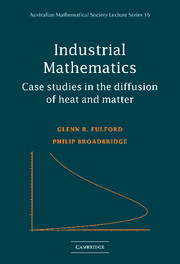1 - Preliminaries
Published online by Cambridge University Press: 14 January 2010
Summary
In this chapter we set the scene by introducing the case studies of the following chapters. We also introduce the main physical concepts for diffusion and heat conduction, and show how to formulate the main partial differential equations that describe these physical processes. Finally, dimensionless variables are introduced and it is shown how to scale differential equations and boundary conditions to make them dimensionless.
Heat and diffusion — A bird's eye view
Here we give a basic physical description of mass transport and heat transport by diffusion. This provides the physical ideas needed to formulate an appropriate differential equation, which is done in the next chapter.
Diffusion
Diffusion is a physical phenomenon involving the mixing of two different substances. Some examples include salt in water, carbon in steel and pollution in the atmosphere.
A fundamental quantity is the concentration of one substance in another. This may be defined in several diffierent ways. For example, the concentration can be measured as the ratio of the mass of one constituent to the total volume of the mixture (kilograms per litre). Another measure of concentration is the volume of one constituent to the total volume of the mixture.
Due to the random motion of constituent particles, concentrations tend to even out. Some molecules in a region of higher concentration move into a region of lower concentration. (See Figure 1.1.1).
Heat and temperature
An important thing to remember about modelling heat transport is that heat and temperature are not the same thing. Heat is a form of energy and may be measured in joules (the SI unit of energy).
- Type
- Chapter
- Information
- Industrial MathematicsCase Studies in the Diffusion of Heat and Matter, pp. 1 - 48Publisher: Cambridge University PressPrint publication year: 2001



